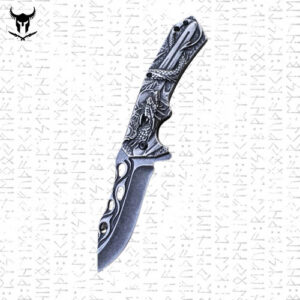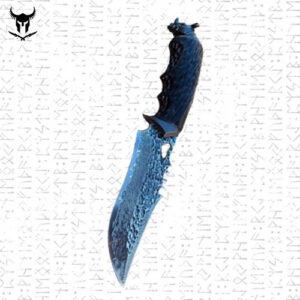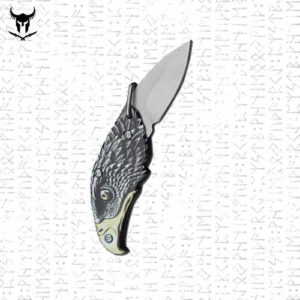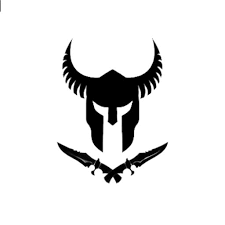Are you curious about the history behind the Viking forge ?
But don’t know where to start? If that’s the case, then I want to tell you that you’re in the right place.
Summary
ToggleThanks to the expertise of my team, we have been able to gather unique and exclusive information.
Now, we will take you through everything related to the art of ancient Viking blacksmiths.
The History of the Viking Forge :
Scandinavian weapons and tools were not just manufactured; they were crafted in the Viking forge with the assistance of their Scandinavian forge god, Volund.
How to Forge a Historical Viking Weapon? “Before the Iron Age” :
The Norse forged iron from bog iron (iron ore found in the land of the Sami people in Sweden). They reduced bog iron to powder, using charcoal and leather bellows to reach high temperatures, up to 1100 degrees Celsius. Iron melts at around 1200 degrees Celsius, but cast iron is very brittle. So, they heated the raw iron for several days until it formed a bloom of iron.
This bloom was :
- Removed from the forge.
- Hammered to form a block.
- Heated again.
- Flattened.
- Folded.
- Finally, hammered again.
This process was repeated several times to remove impurities from the Viking blade.
Viking blacksmiths employed a novel technique, combining pure iron for the core of the blade and steel for the edges. The steel often contained only a few flat pieces of slag, indicating it had been worked longer than the pure iron.

Handmade Viking Damascus Folding Knife - 9 CM Sharp Blade
⚒️ A blade, a legacy — forge yours now.
Buy nowA Significant Step for the Viking Forge :
By using bones, the “spirits” of animals or humans, Nordic blacksmiths were, in a sense, creating a new being. An ancient Scandinavian poetry collection called the Poetic Edda describes many swords that had names (Ulfberht, etc.), some even had what could be called a spirit—some could speak, sing, guide, or bring misfortune to their owner. While we can say with some confidence that Scandinavian blades were not great conversationalists, ancient Viking blacksmiths were, in a way, infusing them with life— that of a famous warrior, a powerful animal, or the departed ancestors of the spirit, thus making steel.
Viking Warrior Forge During the Iron Age :
They didn’t know it, but Viking Iron Age rituals transformed their iron into steel. Iron Age Scandinavians had access only to poor-quality iron, putting them at a tactical disadvantage compared to their neighbors. To strengthen their handmade Viking swords, Viking blacksmiths used the bones of their deceased ancestors and animals, hoping to transfer spirits into their blades. They couldn’t have known that, in doing so, they were forging a rudimentary form of steel.
Science fiction author Arthur C. Clarke once wrote, “Any sufficiently advanced technology is indistinguishable from magic.” Although we usually apply this to the future, the same was true in the past. In much of ancient history, the line between technology and ritual was thin. Blacksmiths were something between craftsmen and magicians, possessing secret and esoteric knowledge. In early Iron Age Scandinavia, just before the Viking Age, Nordic blacksmiths discovered a ritual that allowed them to transfer the strength of steel from their ancestors and animals into their weapons.

Nidhoggr Viking Folding Hunting Knife with High-Hardness Steel Handle
⚒️ A blade, a legacy — forge yours now.
Buy nowA Landmark Discovery for the Nordic Forge : Wayland
This was a crucial transformation for the Vikings; most of the iron they had access to was bog iron. Bacteria in bogs oxidize traces of iron to gain energy and, in doing so, concentrate iron, making it collectible for forging.
However, the resulting iron is impure and soft, which was a significant problem for Viking craftsmen. Conflicts could easily be settled by the party with the best equipment and the favor of the god Wayland.
The Iron Age Scandinavia was full of conflicts, whether against the Romans, neighboring warlords, or Christian settlements; survival depended on defense against or engagement in conflict. Scandinavian forges across Norway contain remains of animal and human bones—in incorporating the remains of the dead, their spirits could be transferred into a scramasax, making it stronger and more durable.
Strengthening the Viking Scramasax with Bone :
Incorporating bones into the Viking forging process did indeed make Scandinavian swords stronger. However, it wasn’t magic; it was Viking technology and art. What ancient blacksmiths couldn’t have realized is that they were actually mixing their bog iron with carbon to create a rudimentary form of steel. Carbon is present in all organic matter, including bones.
By burning bones in a low-oxygen environment, ancient blacksmiths would have produced bone charcoal, much like wood burning in a low-oxygen environment produces charcoal. Researchers have conducted experiments that recreate the sword forging process using bog iron and bone charcoal; the carbon from the bones can penetrate up to three millimeters deep into the bog iron, significantly reinforcing the sword.

High Hardness Outdoor Hunting Knife for Risk Prevention
⚒️ A blade, a legacy — forge yours now.
Buy nowThe Forge of Volund : The Viking Forge God
This is quite important. Note that the saga of Volund is relatively significant, and the god Volund was considered a “magician”; a Viking blacksmith was generally revered (and perhaps occasionally mistrusted—they possessed knowledge that ordinary people did not.)
In England, Wayland Smith (the same individual) is also part of myths and stories.
Vikings were part-time farmers and warriors. For a farmer, the availability of iron tools could make a huge difference in farm productivity and enable the shoeing of horses (blacksmiths actually made horseshoes). For a warrior, the difference between a Viking knife forged by the Forge God Volund or an ordinary spear and a weapon made of high-quality iron or steel could mean the difference between surviving and dying.
That’s why legendary Viking weapons were given names: Gram, Odin’s sword; Dragvandil, Egill Skallagrímsson’s sword; Gungnir, Odin’s spear; or Mjölnir, Thor’s magical hammer.
Was the Blacksmith So Important in the Viking Era ?
Absolutely. The blacksmith was one of the most crucial roles in Viking Age Scandinavia and throughout Europe until the Industrial Revolution.
For medieval Scandinavians, the blacksmith made tools. Hammers and nails, household tools, and later, agricultural equipment. Farriers made horseshoes. In times of war or raid, armorers and blacksmiths crafted swords, axes, helmets, shield bosses, arrowheads, and all sorts of items useful for avoiding death abroad.
Of course, blacksmiths and weapons were important in the Viking Age. But a blacksmith led a tough life, risking soot in their lungs and an early death.

Viking Folding Pocket Knife - Midgardson Eagle Head
⚒️ A blade, a legacy — forge yours now.
Buy nowConsider these questions :
- If you had to start a farm without using modern vehicles, and the closest thing to a combine harvester or tractor is a cow with a plow attached, would you prefer that plow to be made of wood or iron?
- Or if you had to build a house, would you prefer to have iron nails and hammers, or would you try to tie everything together with ropes, perhaps bronze at best?
- Here’s a good one: If you could choose between a stick, stones, or an iron sword for raiding, what would you choose?
You can see why they were important, can’t you?
Furthermore, Thor was famous for being the patron god of blacksmiths.

